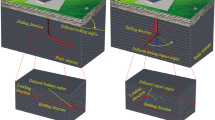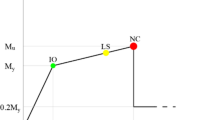Abstract
The coefficients of restitution are among the most important parameters in rockfall trajectory modelling. However, they are difficult to obtain, they depend on many parameters and they present a significant variation even for similar geotechnical and kinematic conditions. Many definitions for the coefficients of restitution exist, but there is no agreement on which describes better the response of a block to an impact. In this paper, an extensive experimental investigation is presented, consisting of 600 oblique impact tests and the various coefficient of restitution definitions are assessed, with an emphasis on the effects of impact angle and angular velocity. These tests follow on the research presented in Asteriou and Tsiambaos (Int J Rock Mech Min Sci 106:41–50, 2018), where free-fall tests were performed to address the effects of impact velocity, block mass and material type. It was found that all those parameters affect significantly the coefficients of restitution. Moreover, an empirical model was proposed to estimate the coefficient of restitution for central impacts. The applicability of this model is extended for oblique impacts based on the results of the tests presented in this paper.










Similar content being viewed by others
References
Asteriou P, Tsiambaos G (2016) Empirical model for predicting rockfall trajectory direction. Rock Mech Eng 49(3):927–941
Asteriou P, Tsiambaos G (2018) Effect of impact velocity, block mass and hardness on the coefficients of restitution for rockfall analysis. Int J Rock Mech Min Sci 106:41–50
Asteriou P, Saroglou H, Tsiambaos G (2012) Geotechnical and kinematic parameters affecting the coefficients of restitution for rock fall analysis. Int J Rock Mech Min Sci 54:103–113
Asteriou P, Saroglou H, Tsiambaos G (2013) Rockfalls: influence of rock hardness on the trajectory of falling rock blocks. Bulletin of the Geological Society of Greece, Greece, vol XLVII
Broili L (1977) Relations between scree slope morphometry and dynamics of accumulation processes. In: Meeting on Rockfall dynamics and protective works effectiveness, pp 11–23
Buzzi O, Giacomini A, Spadari M (2012) Laboratory investigation on high values of restitution coefficients. Rock Mech Rock Eng 45(1):35–43
Cagnoli B, Manga M (2003) Pumice-pumice collisions and the effect of the impact angle. Geophys Res Lett 30(12):1636
Chau K, Wong R, Wu J (2002) Coefficient of restitution and rotational motions of rockfall impacts. Int J Rock Mech Min Sci 39(1):69–77
Descoeudres F, Zimmermann T et al (1987) Three-dimensional dynamic calculation of rockfalls. In: 6th ISRM Congress, International Society for Rock Mechanics
Dorren L (2015) Rockyfor3d (v5.2) revealed-transparent description of the complete 3d rockfall model. Technical. Report. www.ecorisq.org
Ferrari F, Giani G, Apuani T (2013) Why can rockfall normal restitution coefficient be higher than one. Rend Online Soc Geol Ital 24:122–124
Giacomini A, Thoeni K, Lambert C, Booth S, Sloan S (2012) Experimental study on rockfall drapery systems for open pit highwalls. Int J Rock Mech Min Sci 56:171–181
Giani G (1992) Rock slope stability analysis. CRC Press, Boca Raton
Goldsmith W (1960) Impact: the theory and physical behavior of colliding solids. Arnold, London
Habib P (1977) Note sur le rebondissement des blocs rocheux. Rockfall dynamics and protective works effectiveness, ISMES Publication No. 90, pp 123–125
Jones C, Higgins J, Andrew R (2000) Colorado Rockfall Simulation Program: Version 4.0 (for Windows)
Labiouse V, Heidenreich B (2009) Half-scale experimental study of rockfall impacts on sandy slopes. Nat Hazards Earth Syst Sci 9(6):1981–1993
Paronuzzi P (2009) Field evidence and kinematical back-analysis of block rebounds: the Lavone Rockfall, northern Italy. Rock Mech Rock Eng 42(5):783–813
Pfeiffer T, Bowen T (1989) Computer simulation of rockfalls. Bull Assoc Eng Geol 26(1):135–146
RocScience (2003) Advanced tutorial: determining input parameters for a RocFall analysis. www.rocscience.com
Spadari M, Giacomini A, Buzzi O, Fityus S, Giani G (2012) In situ rockfall testing in new south wales, australia. Int J Rock Mech Min Sci 49:84–93
Ulusay R, Hudson J (2007) The complete ISRM suggested methods for rock characterization, testing and monitoring: 1974–2006. International Society for Rock Mechanics, Commission on Testing Methods
Umbach D, Jones K (2003) A few methods for fitting circles to data. IEEE Trans Instrum Meas 52(6):1881–1885
Wu J (1985) Rockfall evaluation by computer simulation. No. 1031
Wyllie D (2014) Calibration of rock fall modeling parameters. Int J Rock Mech Min Sci 67:170–180
Acknowledgements
This post-doctoral research was carried out with a scholarship granted by the State Scholarships Foundation of Greece (IKY) under the act “Supporting Post-Doctoral Researchers” of the Operational Program “Human Resources Development, Education and Life Lifelong Learning” (Thematic Priority Axes 6, 8, 9) and is co-funded by the European Social Fund (ESF) and the Greek Government.
Author information
Authors and Affiliations
Corresponding author
Additional information
Publisher's Note
Springer Nature remains neutral with regard to jurisdictional claims in published maps and institutional affiliations.
Rights and permissions
About this article
Cite this article
Asteriou, P. Effect of Impact Angle and Rotational Motion of Spherical Blocks on the Coefficients of Restitution for Rockfalls. Geotech Geol Eng 37, 2523–2533 (2019). https://doi.org/10.1007/s10706-018-00774-0
Received:
Accepted:
Published:
Issue Date:
DOI: https://doi.org/10.1007/s10706-018-00774-0




